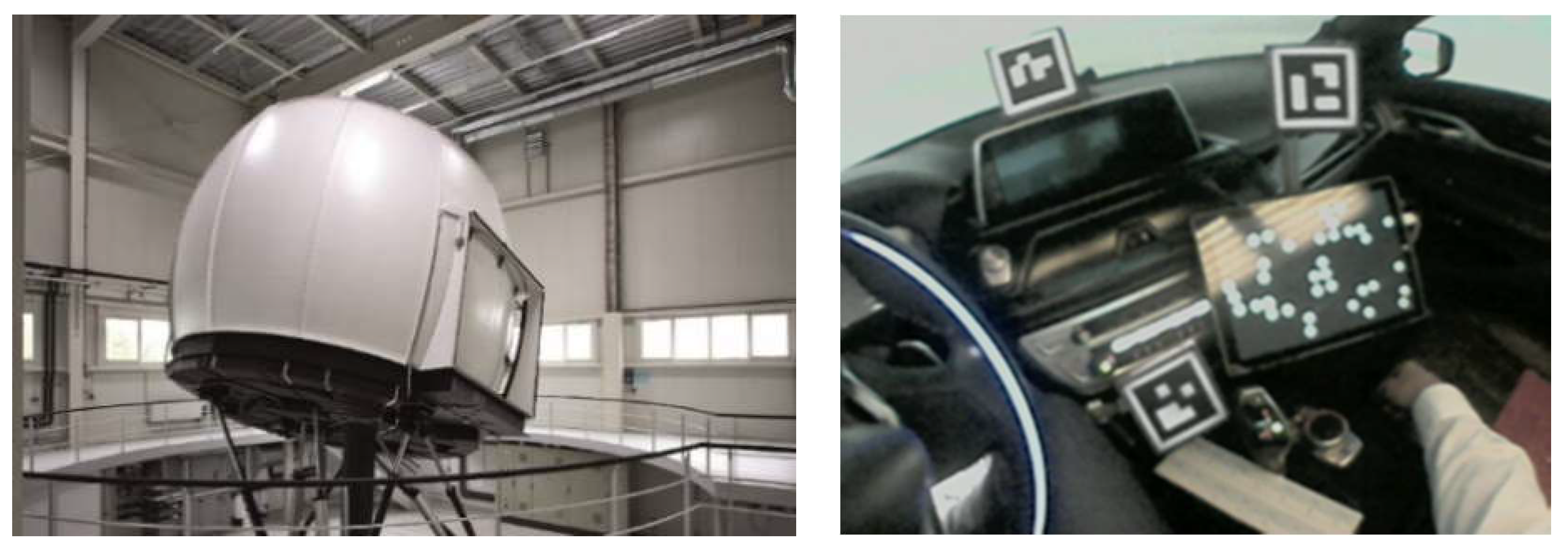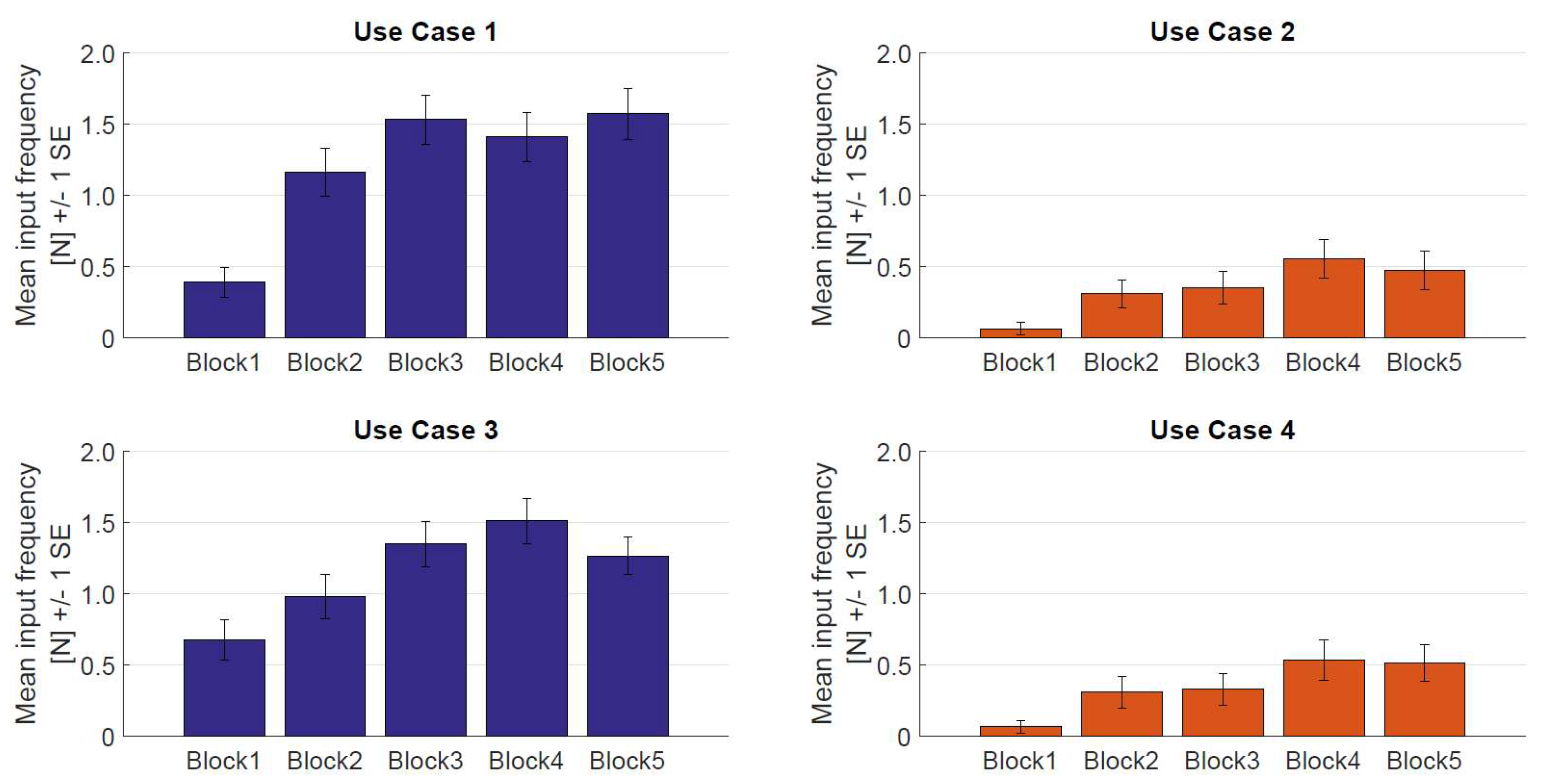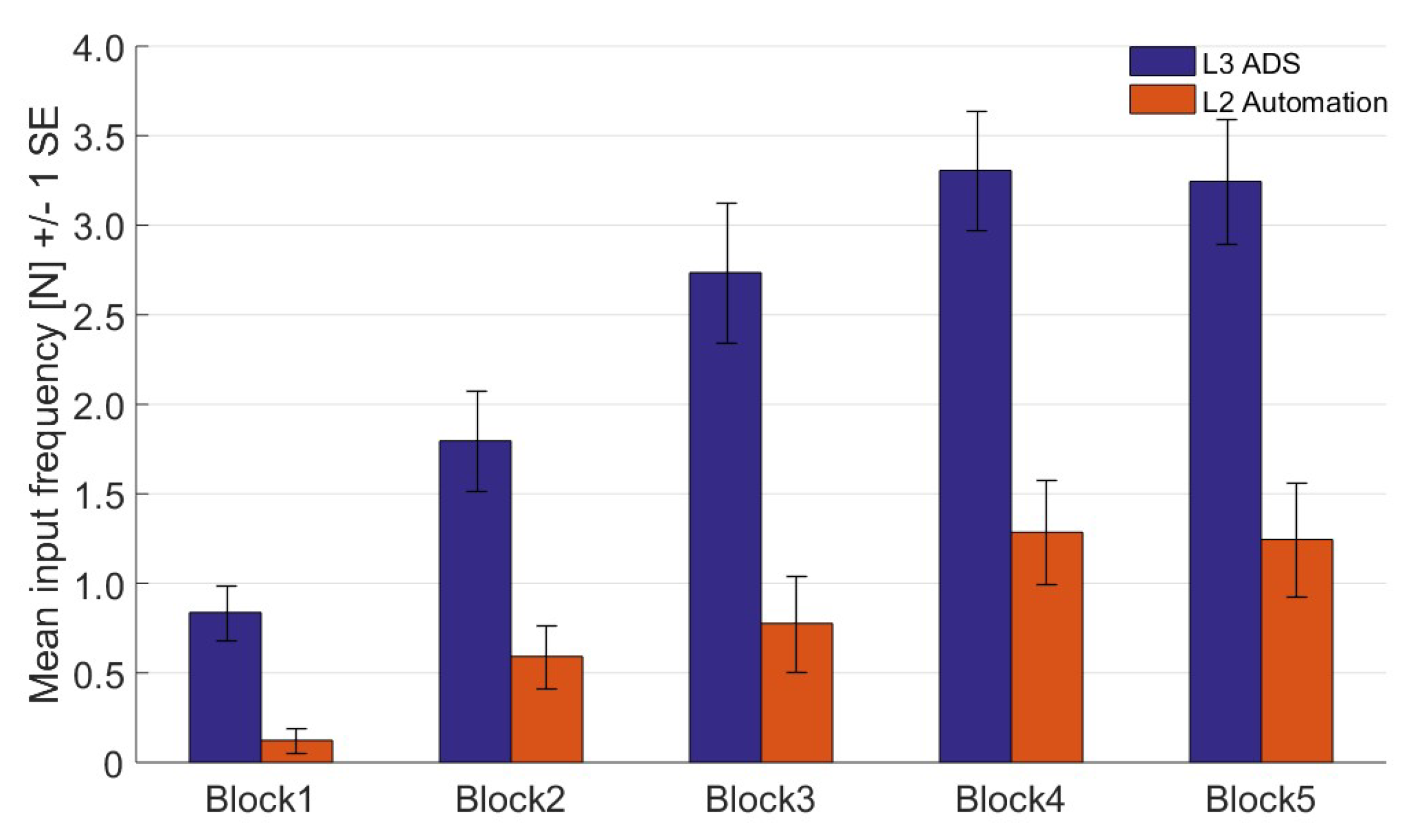In the automotive context, the evaluation of HMIs has a long history. The distraction potential of in-vehicle information systems (IVIS) is the main focus for manual driving (SAE L0). Here, test procedures to assess visual workload associated with the IVIS have already been established [
2,
3]. However, the change of the driver’s role from manual driver to supervisor in L2 and fallback performer in L3 automation renders the application of these methods unfeasible. For example, NHTSA distraction guidelines only permit 2 s per glance and 12 s total glance duration on IVIS. It might be questionable whether these numbers as they were proposed for manual driving are also suitable for L2 automation. In addition, with the driving automation executing longitudinal and lateral vehicle control, distance and lane keeping are not applicable measures for indicating the suitability of an HMI in this particular context. In contrast, a variety of constructs related to the safe driver–automation interaction such as trust [
4,
5,
6,
7] controllability [
8,
9,
10], understanding in form of mental models [
11,
12,
13], or usability [
14] could be used as criteria. Research has shown that these pose challenges to the design and evaluation of automated vehicle HMIs. For an outline of evaluation methods for automated vehicle HMIs see [
15]. One further step towards an ADS method validation concerns the investigation of mode awareness. This term was proposed by Sarter and Woods [
16]. The authors report that even pilots who can be considered highly skilled and trained operators of flight automation can face situations where they are not certain of roles and responsibilities for the aircraft operation task. Such situations can lead to dangerous outcomes and consequently a safety-related assessment is indispensable.
Mode awareness is a central aspect for appropriate and safe human–automation interaction in general and in the context of driving automation in particular. For example, Gopinath and Johansen [
17] outline that mode awareness of operators is of crucial importance for safety when interacting with production robots. By appropriate design of the automation and according HMIs, safety risks can be mitigated (e.g., [
18]). In the driving automation context, Feldhuetter, Segler and Bengler [
19] provide evidence that drivers’ mode awareness is reduced when the vehicle is equipped with additional driving automation functions (see also [
20]). Similar to the proposal by Gopinath and Johansen [
17], they investigated whether an adaptive HMI design could support mode awareness, but could not find an effect. Other research supports their hypothesis that HMI design can affects drivers’ visual behavior. For example, Kraft, Naujoks, Woerle and Neukum [
21] report the impact of the HMI design on glance distributions during active L2 automation. In this study, a reduced and simple display produced positive effects in terms of distraction on both a self-reported and behavioral level. In addition, familiarity-dependent practice effects occurred for glance patterns. In general, behavioral adaptation to automated driving can be expected as outlined in [
22]. An appropriate design of L3 automated vehicle HMIs can support self-reported usability and trust in automation (Hergeth, 2016). Since trust is expected to determine reliance behavior [
6,
23], we assume that such HMI variations can also affect behavioral parameters concerning NDRT engagement. This influence of HMI design on user behavior is of high importance since it must convey information about the driver’s role during active L2 and L3 functioning. Investigating mode awareness between driving episodes, Feldhuetter and colleagues [
24] tested whether manual driving episodes as intermittent features between transitions of L2 and L3 automation can help to promote mode awareness. In this experiment, they operationalized mode awareness via the visual attention towards driving-relevant areas and engagement in NDRTs. The study shows that there is a difference of visual attention allocation and NDRT engagement. However, it remains unknown whether this observation is stable or prone to changes over time. As there is research indicating behavioral changes in interaction with driving automation when interacting repeatedly [
14,
21], NDRT-related behavior might also change. Especially findings of more accurate mental models over time [
11,
12,
13] lead to the question whether mode awareness is also dependent on the familiarity with the driving automation.
As indicated above, reliance behavior is suggested to be closely tied to NDRT engagement during automated driving [
7]. The difference between L2 and L3 is that the driver is responsible for supervising the automation in L2 whereas he/she has to be readily available to perform driving task fallback in L3. For the HMI design, this indicates that L2 automation systems require a feature ensuring that drivers are attentive to the supervising task either by steering wheel input or gaze tracking to the forward roadway (see e.g., [
25]). By issuing a so called “hands-on request” or “attention request”, the system draws the driver’s attention back towards the supervising task. In comparison, such interface features are not part of a L3 system as it allows NDRT engagement. L3 systems only request driver input at operational design domain (ODD) limits or system malfunctions [
26]. Thus, NDRT-related behavior should differ depending on the understanding of the current level of automation (i.e., mode awareness) given an interface is designed in accordance with the prior considerations. The design of automated vehicle HMIs is therefore a crucial aspect for the facilitation of visual attention towards relevant events inside or outside the vehicle [
27,
28]. A study by Llaneras and colleagues [
29] found that drivers tend to engage in NDRTs during reliable L2 automation that does not monitor or restrict behavior. This leads to risky driving and diverts attention away from the roadway and supervision of the system. Therefore, investigation and comparison of NDRT engagement during L2 and L3 automation is of high importance. It is expected that HMI features such as hands-on or attention requests during L2 automation should consequently lead to improved mode awareness with better understanding of his/her roles and responsibilities (i.e., supervising during L2). This understanding eventually translates in observable behavior of less NDRT engagement during L2 as compared to L3 automation.
The study outlined above shows that there is a growing body of research on mode awareness in the driving automation domain. Additionally, HMI considerations outlined above suggest that NDRT engagement can serve as an indicator of mode awareness. However, commonly agreed methodological approaches are still missing. In relation to the theoretical and conceptual developments, the present study’s aim was to investigate how mode awareness can be assessed in a non-intrusive way. It seeks to extend the findings on understanding as reported in [
13]. Results of this publication showed that the general understanding of roles and responsibilities (i.e., mode awareness) was high for both L2 and L3 automation. However, the question remained whether this understanding also translates in observable behavior. Non-intrusive measurements of mode awareness bear both advantages for researchers and practitioners as well as for the real-world application of driver-monitoring systems. On the one hand, during the development and evaluation of automated vehicle HMIs, mode awareness represents a critical issue that needs to be assessed. With the availability of a non-intrusive measure, research methodology benefits from the present research. On the other hand, real-world application could use driver monitoring technology to detect potential losses of mode awareness based on the driver’s current behavior. Thus, an ADS might undertake necessary precautions such as displaying warning messages which are already in effect today for fatigue detection.













